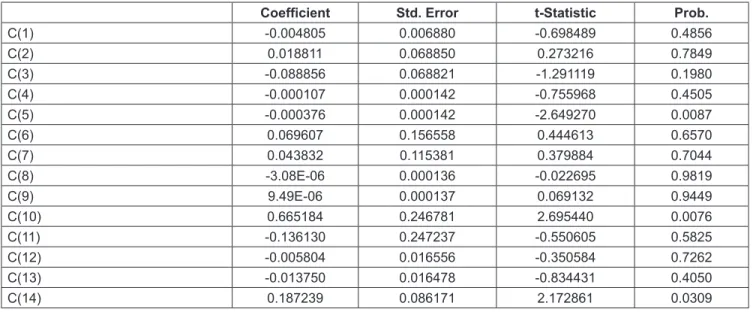Print ISSN: 2288-4637 / Online ISSN 2288-4645 doi:10.13106/jafeb.2020.vol7.no12.123
Dynamics of Crude Oil and Real Exchange Rate in India
Md. Shabbir ALAM
1, Mohammed Ahmar UDDIN
2, Syed Ahsan JAMIL
3Received: September 01, 2020 Revised: October 26, 2020 Accepted: November 05, 2020
Abstract
This scholarly work is an effort to capture the effects of oil prices on the actual exchange rate between dollar and rupee. This is done with reference to the U.S. dollar as oil prices are marked in USD (U.S. Dollar) in the international market, and India is among the top five importers of oil. Using monthly data from January 2001 to May 2020. The study used the real GDP, money supply, short-term interest rate difference between two countries, and inflation apart from the crude oil prices per barrel as the factors that help define the exchange rate.
The analysis, through cointegration and vector error correction method (VECM), suggests long and short-run causality amid prices of oil and the rate of exchange fluctuations. Oil prices are found to be negatively related to the exchange rate in the long term but positively related in the short term. The result of the Wald test also indicates the short-run causation from the short-term interest rate and the prices of crude oil towards the exchange rate. The present study shows that oil prices are evidence of the existence of short-term and long-term driving associations with short-term interest rates and exchange rates.
Keywords: Oil Prices, Exchange Rate, VECM, Co-integration, Causality, India JEL Classification Code: E44, F31, F37, G01, G15
metals, etc. suffer mainly from transaction exposure and operating exposure. USD happened to be the main currency for the pricing of crude oil in the international markets.
India is among the top five nations to import crude oil.
India’s dependency on imported crude oil has gone to 85% in 2019-20, which was around 83% in 2018-19. The oil demand is continuously rising in all the nations irrespective of their economic conditions. The crude oil has become a mode of foreign exchange for exporting nations, leading to a deficit on the balance of payment for the importing country. In India, the crude oil and natural gas production noted a CAGR (cumulative annual growth rate) of 0.15% and (-) 3.61%
during the period 2009-10 to 2018-19. The consumption rose with a CAGR of 3.3% and 0.2% correspondingly at the same time. This gap in production and consumption made India heavily dependent on buying crude oil from other countries.
Crude oil imports reached to 226.50 MTs in 2018-19 from 159.26MTs during 2009-10. The prices of crude oil per barrel are currently at the lowest in the last few years. The import is mainly from Iraq, Saudi Arabia, and sometimes the U.S. The bin of Indian crude oil on an average had a price of $33.36 per barrel in March 2020 in comparison to $66.74 per barrel in March 2019. The crude oil prices decreased to almost two-thirds since the beginning of the year 2020 due to a decline in demand in the era of this pandemic. However, this decrease has been offset by the depreciation in the value
1. Introduction
International trade has always been a way of generating foreign exchange for all nations. The international market, post-Bretton wood, has worked on the floating exchange rate and pegging the currency mainly to dollar or euro.
This pegging causes foreign exchange exposure in terms of transaction risk, translation risk, and operating or economic exposure. Exposure can be described as variation in the actual domestic exchange value of an asset and obligations or operating incomes due to unexpected variations in the exchange rate. The international trade of goods such as oil,
1
First Author and Corresponding Author. Assistant Professor, Department of Finance and Economics, College of Commerce and Business Administration, Dhofar University, Sultanate of Oman [Postal Address: P.O. Box 2509, Salalah, 211, Sultanate of Oman]
Email: shabbir.alam28@gmail.com
2
Assistant Professor, Department of Finance and Economics, College of Commerce and Business Administration, Dhofar University, Sultanate of Oman. Email: ahmar@du.edu.om
3
Associate Professor, Department of Finance and Economics, College of Commerce and Business Administration, Dhofar University, Sultanate of Oman. Email: syed_jamil@du.edu.om
© Copyright: The Author(s)
This is an Open Access article distributed under the terms of the Creative Commons Attribution Non-Commercial License (https://creativecommons.org/licenses/by-nc/4.0/) which permits unrestricted non-commercial use, distribution, and reproduction in any medium, provided the original work is properly cited.


